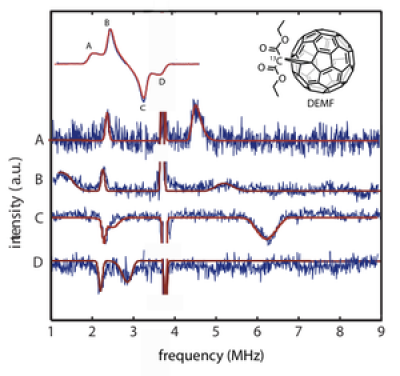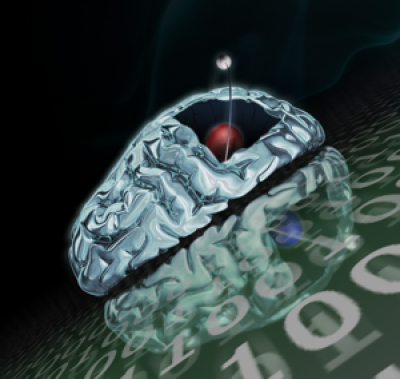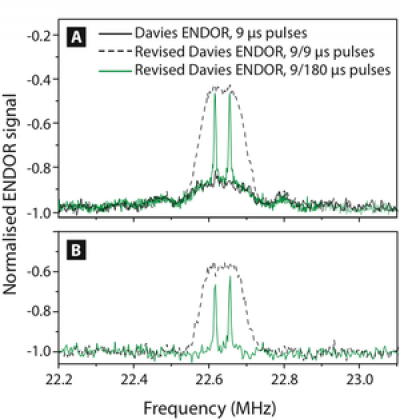It Takes Two to Tangle: An Entangled Ensemble of Electron-Nucleus Spin Pairs

Ensembles of spins controlled using magnetic resonance have provided the first, most advanced, and highest fidelity experimental demonstrations of quantum algorithms to date, however they have until recently been unable to produce on-demand entanglement - the most critical ingredient for a pure-state quantum computer. Entanglement requires a high degree of polarisation, and to build upon the natural polarisation of electron-phosphorus donor pairs embedded in a high-purity Si-28 crystal at 2.9K and 3.4T, we performed a hyperpolarisation sequence to further reduce the spin entropy of the state. Once polarised, the entangled state was generated and its density matrix measured using quantum state tomography, which was then analysed for entanglement. Reading out the state resulted in a 98% fidelity with the target entangled state at this field and temperature.
Entanglement in a solid-state spin ensemble
Stephanie Simmons, Richard M. Brown, Helge Riemann, Nikolai V. Abrosimov, Peter Becker, Hans-Joachim Pohl, Mike L. W. Thewalt, Kohei M. Itoh & John J. L. Morton
Nature 470 49 (2011) Link
A proposal for entangling remote nuclear spins linked by a chromophore

Nuclear spins can be efficiently polarized when coupled to optically excited electron spins. Furthermore, we propose a scheme that introduces entanglement between nuclear spins through their mutual coupling to an excited electron spin via the hyperfine interaction. In order to investigate the practicality of this proposal we use pulsed magnetic resonance techniques on a modified fullerenic structure and we extract the spin Hamiltonian for the coupled system. We perform ENDOR experiments for the determination of the full hyperfine tensor and from the relaxation kinetics we obtain the initial polarization of the triplet state and the spin relaxation rates . The theoretical model together with our experiments and density functional calculations identify specific molecular properties that permit high entangling power gates under optical, radiofrequency and microwave pulses.
Entangling remote nuclear spins linked by a chromophore
M Schaffry, V Filidou, SD Karlen, EM Gauger, SC Benjamin, HL Anderson, A Ardavan, GAD Briggs, K Maeda, KB Henbest, F Giustino, JJL Morton, BW Lovett ,
Phys Rev Lett 104 200501 (2010) Link
Memoirs of a silicon qubit: coherent storage beyond a second

A powerful model for quantum computation is thus one in which electron spins are used for processing and readout while nuclear spins are used for storage. We have demonstrated the coherent transfer of a superposition state in an electron spin 'processing' qubit to a nuclear spin 'memory' qubit, using a combination of microwave and radiofrequency pulses applied to 31P donors in an isotopically pure 28Si crystal. The electron spin state can be stored in the nuclear spin on a timescale that is long compared with the electron decoherence time and then coherently transferred back to the electron spin, thus demonstrating the 31P nuclear spin as a solid-state quantum memory. The coherence lifetime of the quantum memory element is found to exceed one second at 5.5K.
Solid state quantum memory using the 31P nuclear spin
John J. L. Morton, Alexei M. Tyryshkin, Richard M. Brown, Shyam Shankar, Brendon W. Lovett, Arzhang Ardavan, Thomas Schenkel, Eugene E. Haller, Joel W. Ager, S. A. Lyon,
Nature 455 1085 (2008) Link
Tidy Davies ENDOR

Over the past 50 years, electron-nuclear double resonance (ENDOR) has become a fairly ubiquitous spectroscopic technique, allowing the study of spin transitions for nuclei which are coupled to electron spins. However, the low spin number sensitivity of the technique continues to pose serious limitations. Here we demonstrate that signal intensity in a pulsed Davies ENDOR experiment depends strongly on the nuclear relaxation time T1n, and can be severely reduced for long T1n. We suggest a development of the original Davies ENDOR sequence that overcomes this limitation, thus offering dramatically enhanced signal intensity and spectral resolution. Finally, we observe that the sensitivity of the original Davies method to T1n can be exploited to measure nuclear relaxation, as we demonstrate for phosphorous donors in silicon and for endohedral fullerenes N@C60 in CS2.
Nuclear relaxation effects in Davies ENDOR variants
John J. L. Morton, Nick S. Lees, Brian M. Hoffman and Stefan Stoll,
Journal of Magnetic Resonance 191 315 (2008) Link
Davies electron-nuclear double resonance revisited: Enhanced sensitivity and nuclear spin relaxation
Alexei M. Tyryshkin, John J. L. Morton, Arzhang Ardavan, S. A. Lyon,
Journal of Chemical Physics 124 234508 (2006) Link
 Close
Close

